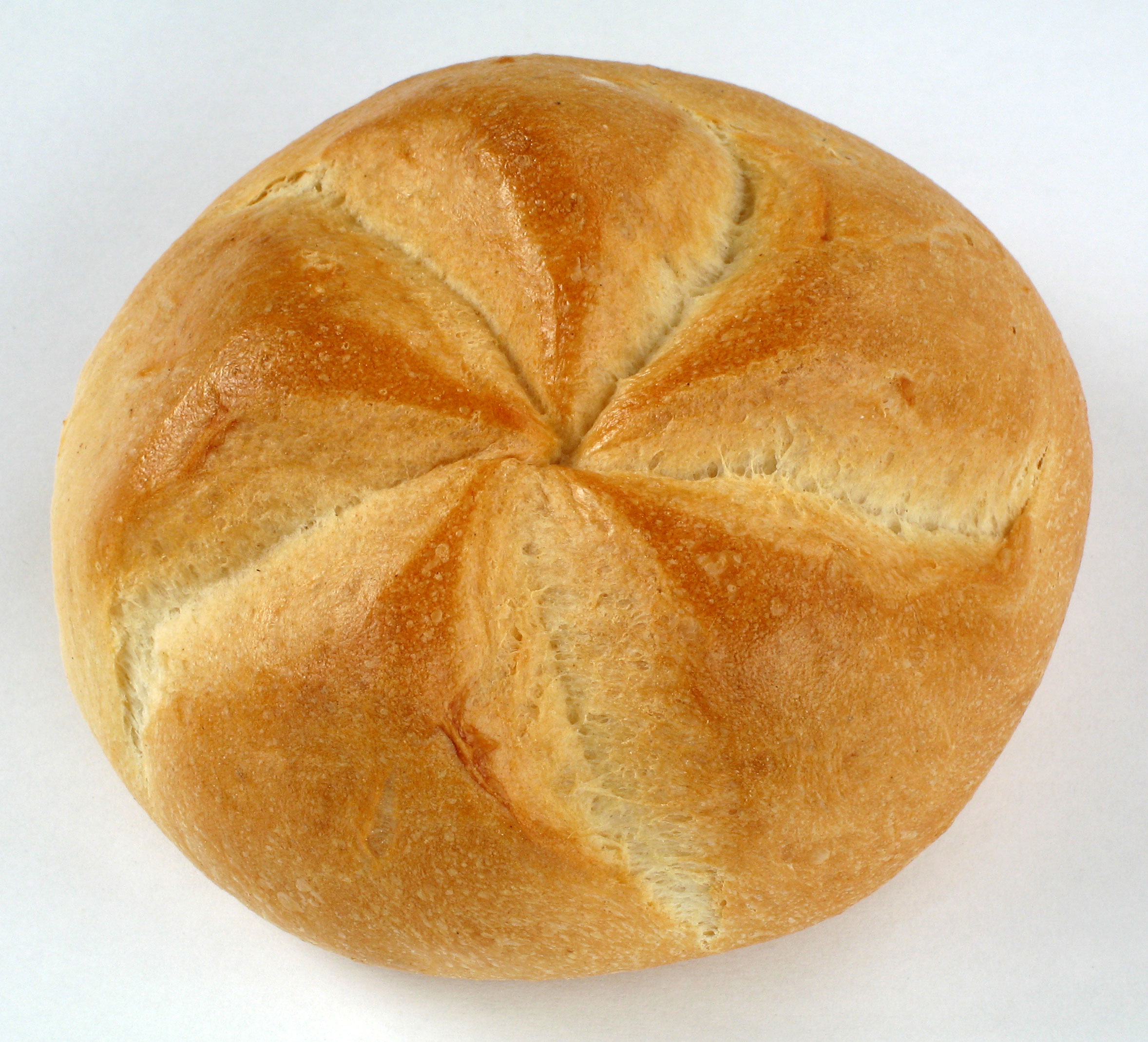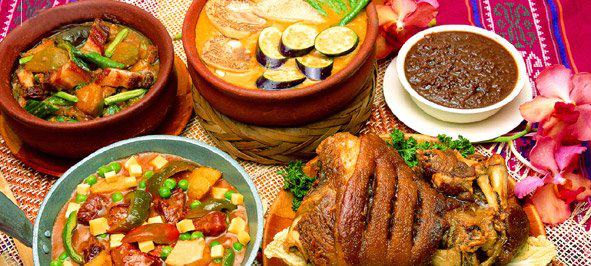|
Asado Roll
Asado rolls, also called asado buns or baked siopao, is a Filipino bread roll filled with savory-sweet pork asado. It is similar to the asado siopao except it is baked (not steamed). The top can either be covered with an egg wash, bread crumbs, or sprinkled with sesame seeds. See also *Pan de coco Pan de coco, literally "coconut bread" in Spanish, is a Filipino rich sweet roll that uses sweetened shredded coconut meat (''bukayo'') as filling. It is one of the most popular types of bread in the Philippines, usually part of the "Filipino ... References Philippine breads Southeast Asian breads {{Filipino food ... [...More Info...] [...Related Items...] OR: [Wikipedia] [Google] [Baidu] |
Baked Siopao
Baking is a method of preparing food that uses dry heat, typically in an oven, but it can also be done in hot ashes, or on hot stones. Bread is the most commonly baked item, but many other types of food can also be baked. Heat is gradually transferred from the surface of cakes, cookies, and pieces of bread to their center, typically conducted at elevated temperatures surpassing 300 °F. Dry heat cooking imparts a distinctive richness to foods through the processes of caramelization and surface browning. As heat travels through, it transforms batters and doughs into baked goods and more with a firm dry crust and a softer center.p.38 Baking can be combined with grilling to produce a hybrid barbecue variant by using both methods simultaneously, or one after the other. Baking is related to barbecuing because the concept of the masonry oven is similar to that of a smoke pit. Baking has traditionally been performed at home for day-to-day meals and in bakeries and restaurants f ... [...More Info...] [...Related Items...] OR: [Wikipedia] [Google] [Baidu] |
Philippine Asado
Philippine ''asado'' refers to two different Filipino braised meat dishes. The name originates from Spanish ''asado'' ("grilled"), a reference to the original dish it was applied to, the Chinese-Filipino version of ''char siu'' barbecues usually known as pork ''asado''. However, Filipino versions have evolved to be braised, not grilled. The other Filipino dishes also known as ''asado'' are ''asado de carajay'' and ''asado matua''. Unlike the Chinese-derived version, they are savory rather than sweet. Variations ''Asado de carajay'' ''Asado de carajay'' is a native ''asado''. The name is derived from Philippine Spanish ''carajay'' (" wok", ì or ''kalaha'' in Philippine languages). ''Asado de carajay'' is made with meat (pork, beef, or chicken) braised in soy sauce, bay leaves, peppercorns, calamansi, onions, and various vegetables (usually tomatoes, potatoes, mushrooms, and carrots). It is traditionally cooked in a wok, hence the name. ''Asado de carajay'' is differentiated f ... [...More Info...] [...Related Items...] OR: [Wikipedia] [Google] [Baidu] |
Siopao
''Siopao'' (), is a Philippine steamed bun with various fillings. It is the indigenized version of the Fujianese ''baozi'', introduced to the Philippines by Hokkien immigrants during the Spanish colonial period. It is a popular snack in the Philippines and is commonly sold by bakeries and restaurants. Description Siopao is derived from the baozi, introduced by Hokkien Chinese immigrants to the Philippines during the Spanish colonial period. The name is derived from Philippine Hokkien ''sio-pau'' (). Historically, the most popular siopao buns in Manila were the ones made by restaurateur Ma Mon Luk at the turn of the 20th century. Siopao differs from the baozi in that it is much larger and is eaten held in the hands like a sandwich. It also uses different traditional fillings. The most common fillings are pork '' asado'' (indigenized braised version of the Cantonese '' char siu'') and '' bola-bola'' (literally "meatball", a combination of pork, chicken, beef, shrimp or s ... [...More Info...] [...Related Items...] OR: [Wikipedia] [Google] [Baidu] |
Philippines
The Philippines, officially the Republic of the Philippines, is an Archipelagic state, archipelagic country in Southeast Asia. Located in the western Pacific Ocean, it consists of List of islands of the Philippines, 7,641 islands, with a total area of roughly 300,000 square kilometers, which are broadly categorized in Island groups of the Philippines, three main geographical divisions from north to south: Luzon, Visayas, and Mindanao. With a population of over 110 million, it is the world's List of countries and dependencies by population, twelfth-most-populous country. The Philippines is bounded by the South China Sea to the west, the Philippine Sea to the east, and the Celebes Sea to the south. It shares maritime borders with Taiwan to the north, Japan to the northeast, Palau to the east and southeast, Indonesia to the south, Malaysia to the southwest, Vietnam to the west, and China to the northwest. It has Ethnic groups in the Philippines, diverse ethnicities and Culture o ... [...More Info...] [...Related Items...] OR: [Wikipedia] [Google] [Baidu] |
Bread Roll
A bread roll is a small, oblong individual loaf of bread served as a meal accompaniment (eaten plain or with butter). Rolls can be served and eaten whole or are also commonly cut and filled – the result of doing so is considered a '' sandwich'' in English. Europe Rolls are common throughout Europe. Even in the same languages, rolls are known by a variety of names. Some European languages have many local and dialectal terms for bread rolls. These include German language diminutives of ''Brot'' (bread) in most of western and central Germany (where they are called ''Brötchen'') and in Switzerland (where they are called ''Brötli''). Other German language terms include ''Rundstück'' ("round piece") in Hamburg and Schleswig-Holstein; ''Weckerl'' or more specific ''Semmel'' in Austria, Saxony and southern Bavaria; ''Weck'' and ''Weckle'' in much of Baden-Württemberg, Franconia and Saarland; ''Schrippe'' in Berlin and parts of Brandenburg. Some of these names reappear in other E ... [...More Info...] [...Related Items...] OR: [Wikipedia] [Google] [Baidu] |
Filipino Cuisine
Filipino cuisine is composed of the cuisines of more than a hundred distinct Ethnic groups in the Philippines, ethnolinguistic groups found throughout the Philippines, Philippine archipelago. A majority of mainstream Filipino dishes that comprise Filipino cuisine are from the food traditions of various ethnolinguistic groups and tribes of the archipelago, including the Ilocano people, Ilocano, Pangasinan people, Pangasinan, Kapampangan people, Kapampangan, Tagalog people, Tagalog, Bicolano people, Bicolano, Visayan, Chavacano, and Maranao people, Maranao ethnolinguistic groups. The dishes associated with these groups evolved over the centuries from a largely indigenous (largely Austronesian peoples, Austronesian) base shared with maritime Southeast Asia with varied influences from Chinese cuisine, Chinese, Spanish cuisine, Spanish, and American cuisine, American cuisines, in line with the major waves of influence that had enriched the cultures of the archipelago, and adapted us ... [...More Info...] [...Related Items...] OR: [Wikipedia] [Google] [Baidu] |
Pork Asado
Philippine ''asado'' refers to two different Filipino cuisine, Filipino braised meat dishes. The name originates from Spanish language, Spanish ''asado'' ("grilled"), a reference to the original dish it was applied to, the Filipino Chinese cuisine, Chinese-Filipino version of ''char siu'' barbecues usually known as pork ''asado''. However, Filipino versions have evolved to be braised, not grilled. The other Filipino dishes also known as ''asado'' are ''asado de carajay'' and ''asado matua''. Unlike the Chinese-derived version, they are savory rather than sweet. Variations ''Asado de carajay'' ''Asado de carajay'' is a native ''asado''. The name is derived from Philippine Spanish ''carajay'' ("wok", ì or ''kalaha'' in Philippine languages). ''Asado de carajay'' is made with meat (pork, beef, or chicken) braised in soy sauce, bay leaves, peppercorns, calamansi, onions, and various vegetables (usually tomatoes, potatoes, mushrooms, and carrots). It is traditionally cooked in a wo ... [...More Info...] [...Related Items...] OR: [Wikipedia] [Google] [Baidu] |
Egg Wash
An egg wash is beaten eggs, sometimes mixed with another liquid such as water or milk, which is brushed onto the surface of a pastry before baking. Egg washes are also used as a step in the process of breading foods, providing a substrate for the breading to stick to. Egg washes can also be used on calzones or on fish. Use in pastries An egg wash is often used to make pastries shiny and golden or brown in color. It is also used to help toppings or coatings stick to the surface of the pastry, or to bind pastry parts together, such as empanadas or other en croute recipes. Egg wash can usually be made with 30 ml or two tablespoons of liquid, such as milk or water, for every egg. Less liquid makes for a darker wash. The part of the egg used and liquid added determines the finished look of the crust. Vegan varieties Vegan substitutes for egg wash include vegetable oil, non-dairy milk and butter substitutes, and light corn syrup Corn syrup is a food syrup that is made from the st ... [...More Info...] [...Related Items...] OR: [Wikipedia] [Google] [Baidu] |
Sesame Seeds
Sesame (; ''Sesamum indicum'') is a plant in the genus ''Sesamum'', also called benne. Numerous wild relatives occur in Africa and a smaller number in India. It is widely naturalized in tropical regions around the world and is cultivated for its edible seeds, which grow in pods. World production in 2018 was , with Sudan, Myanmar, and India as the largest producers. Sesame seed is one of the oldest oilseed crops known, domesticated well over 3,000 years ago. ''Sesamum'' has many other species, most being wild and native to sub-Saharan Africa. ''S. indicum,'' the cultivated type, originated in India. It tolerates drought conditions well, growing where other crops fail. Sesame has one of the highest oil contents of any seed. With a rich, nutty flavor, it is a common ingredient in cuisines around the world. Like other foods, it can trigger allergic reactions in some people and is one of the nine most common allergens outlined by the Food and Drug Administration. Etymology The wo ... [...More Info...] [...Related Items...] OR: [Wikipedia] [Google] [Baidu] |
Pan De Coco
Pan de coco, literally "coconut bread" in Spanish, is a Filipino rich sweet roll that uses sweetened shredded coconut meat (''bukayo'') as filling. It is one of the most popular types of bread in the Philippines, usually part of the "Filipino bread basket" with the Filipino "spanish bread" and pan de sal, commonly served for breakfast or merienda. See also * Asado roll *Pandesal * Pan de monja (Monáy) * Queijadinha * Wingko *Serabi , , or is a traditional Bali–Java snack, similar to a pancake, made of a rice flour-based batter with coconut milk or coconut cream and shredded coconut as an emulsifier. Most traditional tastes sweet, as these pancake-like desserts are usu ... References Sweet breads Foods containing coconut Philippine breads Southeast Asian breads {{Filipino food ... [...More Info...] [...Related Items...] OR: [Wikipedia] [Google] [Baidu] |
Philippine Breads
The Philippines, officially the Republic of the Philippines, is an Archipelagic state, archipelagic country in Southeast Asia. Located in the western Pacific Ocean, it consists of List of islands of the Philippines, 7,641 islands, with a total area of roughly 300,000 square kilometers, which are broadly categorized in Island groups of the Philippines, three main geographical divisions from north to south: Luzon, Visayas, and Mindanao. With a population of over 110 million, it is the world's List of countries and dependencies by population, twelfth-most-populous country. The Philippines is bounded by the South China Sea to the west, the Philippine Sea to the east, and the Celebes Sea to the south. It shares maritime borders with Taiwan to the north, Japan to the northeast, Palau to the east and southeast, Indonesia to the south, Malaysia to the southwest, Vietnam to the west, and China to the northwest. It has Ethnic groups in the Philippines, diverse ethnicities and Culture o ... [...More Info...] [...Related Items...] OR: [Wikipedia] [Google] [Baidu] |





